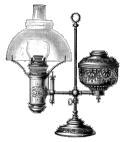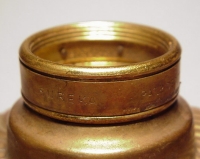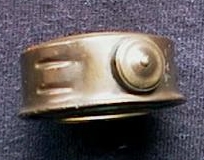|
The following exerpts are from The Willimantic Chronicle, Willimantic, Windham County, Connecticut. The Chronicle was published every Wednesday by McDonald & Safford, Editors and Publishers. They list their address as "Office, Hall's Block, Main & Union Sts." A subscription cost $1.50 per year. All of these items relate to the dangers associated with the use of kerosene lamps. This represents a little more than a three year period in the town of Willimantic and the surrounding area. It is difficult to imagine the loss of life and property that resulted across the nation because of improper use, carelessness, and general accidents involving kerosene lamps.
Here is another Collar Safety Device. This one was patented on July 24, 1877. This patent #193,525, for "improvement in safety-valves for lamps," was issued to John H. Lewars and Charles Klaitz, also from Philadelphia, Penn. Their claim, similar to Wetherill's, is achieved by the use of a valve (the button-shaped piece in the above picture), the pressure upon which is maintained by a piece of spring-brass on the inside of the device. It is unclear how successful these devices were. Wed Jan 21 1880: The contract for lighting the street lamps has been withdrawn from Geo. H. Parks and awarded to John Killourey, who took charge of the lights last week. The burners have all been removed to be cleaned and repaired, and we may expect better service from them hereafter. Wed Jan 21 1880: George Park's wagon house was slightly damaged by fire Monday evening. The fire took from a burning lamp, and would have destroyed the house and its contents but for the presence of persons on the premises. Wed Feb 18 1880: The Eureka Safety Valve, is the name of an invention for preventing lamps from exploding. It is very simple in construction, but it is a sure prevention. People commonly think little of this danger until it happens; but it is better to never have it happen. Geo. M. Harrington has the exclusive right for their sale in this town. Wed Jun 16 1880: As a boy named Ahearn was lighting the street lamps on Main street on Friday evening the gasoline in the filler caught fire. The boy's pants were wet with the combustible fluid, and in an instant they were in flames. He might have lost his life but for the prompt action of the bystanders who went to his assistance and smothered the flames. As it was, he was severely burned on one leg and hand. He was taken to Wilson & Leonard's drug store and the injured parts covered with carbonate of soda, which is very highly recommended for the cure of burns, and afterwards taken home. The wagon, meanwhile was a mass of flames, which were extinguished by pails of water before the fire reached the tank containing the gasoline. The wagon was but little injured. Wed Jul 7 1880: The young man who was so badly burnt a short time ago while lighting the street lamps has recovered and is on the cart again. Wed Sep 1 1880: The house of George Leavens in Danielsonville came near being consumed by fire by the explosion of a kerosene lamp last week. Wed Sep 15 1880: About bedtime Monday night the community was startled by the cry of fire issuing from the barber shop of Wm. Connor and in a moment the whole front of the building was brightly illuminated by the blaze. Immediately the fire bell was sounding and in a short time crowds of people from all directions came rushing to the scene anxious to do what they might to extinguish the blaze, but their services were unnecessary as a few pails of water together with Mr. Connor's coat were sufficient to quench the conflagration. The fire was caused by the explosion of a kerosene lamp and would probably not have occurred had the lamps been provided with the "Eureka safety valve" designed for this purpose and for sale by G.M. Harrington. Had the fire got any headway that whole corner of wooden buildings, notwithstanding the rain that was in progress at the time, would at this time been a charred mass of timber and ruins. The "Hooks" were first on the spot ready for action. The loss to property was slight. Wed Feb 2 1881: The old Marcy factory, in this place, occupied as a tenement house was burned on Friday. The fire occurred on Friday night and resulted in the total loss of the building, and, what was much more serious, the loss of three human lives--a Mrs. Stone and her two children perishing in the flames. The building was formerly used as a shoe manufactory, but for the past five years it has been wholly used as a tenement house with the exception of one room which was used for a grocery store. The building was three stories high and about 200 feet long. It is owned by one of the Marcy Brothers of Hartford. The insurance is about $4,000 and the total loss will not exceed $8,000. Eight families occupied it. Particulars show that the fire took in the apartments occupied by Mrs. Stone, and the theory is that it was caused by the upsetting of a lamp. The children who were burned to death were a boy aged 1 year and six months and a girl aged 5. The babe was found outside the burning building, and the assumption is that the mother placed it there and then returned for the other child, but was cut off by the flames and both perished. The babe was yet alive when found, but it was so badly burned it did not live long. The building was three hundred feet long and originally cost $15,000. It was insured for $2,000 in the Tolland County Mutual and for $500 in the Hartford County Mutual. The grocery store was insured for $1,000 in the Phoenix of Hartford. Wed Jul 27 1881: The punishment which was awarded to a bad boy Saturday we hope will serve as a warning to others similarly inclined. It was the penalty of willfully stoning and breaking glass in street lamps, in which misdemeanor he was detected. The sentence was made light as possible on account of sympathy for the boy's parents, who are responsible people and esteemed by their neighbors. It was fifteen days in the county jail. Boys, heed the warning! Wed Nov 16 1881: Hugh Carney has purchased the patent right of G.M. Harrington of introducing in this vicinity a safety valve for preventing the explosion of kerosene lamps. It is really an attachment of value in overcoming the danger of kerosene lamps. Wed Jan 25 1882: South Coventry. A kerosene lamp was accidentally broken in the carding room of John M. Wood's mill on Thursday evening. The prompt action of employees extinguished the flames and prevented a serious fire. Wed Feb 15 1882: Mrs. Angeline Fish came near being seriously burned, the other evening, from her clothing taking fire from a match with which she was lighting a lamp. Her dress skirt was burned off and her under skirts burned through in places before the fire was extinguished. Wed Mar 1 1882: Scotland. A student lamp exploded in the house of Mrs. David Fuller last week causing damages to the amount of 10 or 12 dollars. Wed Dec. 6, 1882: Samuel Bonner repairs shoes in Coffey & Hurlbert’s brick building on upper Main street and lives in the third story. Friday evening about 9 o’clock a fire was discovered in his apartment by an adjoining tenant who sounded an alarm. The department responded quickly and for a short time there was violent commotion about the streets, and everybody was anxious to lend a hand towards extinguishing the flames if they could be found, but it was soon found that all chance for assistance had been cut off by the application of a couple buckets of water, thus depriving the department of the privilege of exhibiting its skill in subduing the elements. The damage was nothing. It is said that a capsized lamp caused the trouble. Wed Apr. 18, 1883: Geo. M. Harrington keeps a First-Class Line of Groceries, Boots and Shoes, and Domestic Dry Goods, and ____ces will always be found in accordance with the Lowest Market Prices. Our Stock is complete as can be found anywhere, and it will be our highest aim to please our customers in every respect. We Deliver Goods to any part of the village. Geo. M. Harrington, Upper Main Street. Agent for this town for Eureka Safety Valve, for preventing the explosion of kerosene lamps. Nobody should be without them. Wed May 23, 1883: The Granite State Disaster. The Steamer burned to the water’s edge at Goodspeed’s landing on the Connecticut River – two lives lost and all her freight destroyed – her fortunate nearness to the wharf prevents a dreadful calamity. The steamer Granite State, which runs between Hartford and New York, was totally destroyed by fire about 5 o’clock Friday morning while approaching her wharf at Goodspeed’s Landing, forty-one miles below Hartford, on her way to that city. Two persons lost their lives, nine horses were burned to death, and the cargo mostly freight billed for Hartford is a total loss. The Discovery of the Fire. The discovery of the boat being on fire was due to a passenger, whose name cannot be ascertained. At about 4 o’clock he detected the odor of burning wood work and at once notified a deck hand of the fact. The latter said that the odor was probably due to the fires which were being kindled in the cook’s galley. Not satisfied with this the passenger went forward and found that one of the hanging kerosene lamps in the main stairway had ignited the wood work, which was blazing rapidly. Captain Dibble and Clark Silloway were notified and decided at once to run the steamer for Goodspeed’s. The Fatalities. Had the disaster occurred between any two landings in the river or in the sound the loss of life would doubtless have been terrible. As it was, the fatalities were not over two in number, probably. The full list of passengers was not saved, but those known to have been lost are Mrs. Clifford L. Main of New Haven, aged twenty years, and the colored second cook named Jackson of Springfield. Wed Aug 29, 1883: Mr. Leary, an old and very worth citizen, who lives in the extreme western region of this town lost his house and the adjoining sheds and buildings, by fire last Friday night about 9 o'clock, p.m. The youngest daughter a young lady, had gone to her chamber to retire. She had placed the lamp on a light stand which by some means was overturned, and the lamp broken. The oil ignited and carried the flames under the bed, when her efforts to quench the blaze by smothering, were unavailing. Her father had gone to sleep. The whole premises were soon in flames, and little was saved besides the family. The insurance was $400 on the house and $200 on the furniture. The premises were remote from neighbors, who soon arrived after the alarm was given and gave refuge to the unfortunate family. A singular instance of the transmission of sound at night was noticed. A Negro Indian named Freeman living in North Ashford, between three and four miles from West Woodstock was heard at the latter place shouting the alarm. Wed Aug 29, 1883: Early Saturday morning the body of Simon B. Squires was found in the back yard of the Southport National bank, Southport, burned in a shocking manner. It is thought he rose during the night when his lamp exploded and set his clothes on fire. Wed Sep 12, 1883: Mrs. Lucina W. Evitts of New Milford, was badly burned by the capsizing of a lamp last Thursday, and died of her injuries. Wed Dec 12, 1883: Theodore Potvin, of the opera house hair dressing rooms, while going down cellar with a lamp in his hand Thursday night stepped on a round stick of wood and fell down the entire flight. He struck his head against a stone and received an ugly gash on the scalp and forehead, but fortunately the light was extinguished or the accident might have been a very serious one. Wed Jan 16, 1884: Columbia. A lighted lamp tipped over and broke at Victor Penre's and the oil ignited but owing to Mrs. P's presence of mind, she seized a rug and covered the flames thereby avoiding serious consequences. Wed Feb 13, 1884: Engine No. 33 of the New England road, which draws the passenger train leaving this station for Hartford at 4:10 p.m., exploded the lamp of its head-light down in yard Monday. The front of the engine was covered with the blazing oil, and for a moment things looked enough like a bad accident to attract a crowd. The blaze was extinguished by a bucket or two of water. Wed Apr 23, 1884: Mrs. Mary McGoldrick, aged 73 years, of New Haven, Ct., and Emma O'Brien, aged 3 years, of Erie, Pa., were yesterday burned to death by the explosion of kerosene lamps. |

| Reference Desk | Lamp Information | Other Resources | On-Line Shopping |

Purveyors of Antique Lighting and Accessories
435 Main Street
 Hurleyville, New York 12747
Hurleyville, New York 12747
The Dangers of Kerosene Lamps
^ Top of Page
Privacy Policy | Terms and Conditions of Use | Announcements
Copyright © 2001-2011 ~ Daniel Edminster | The Lampworks ~ All Rights Reserved


